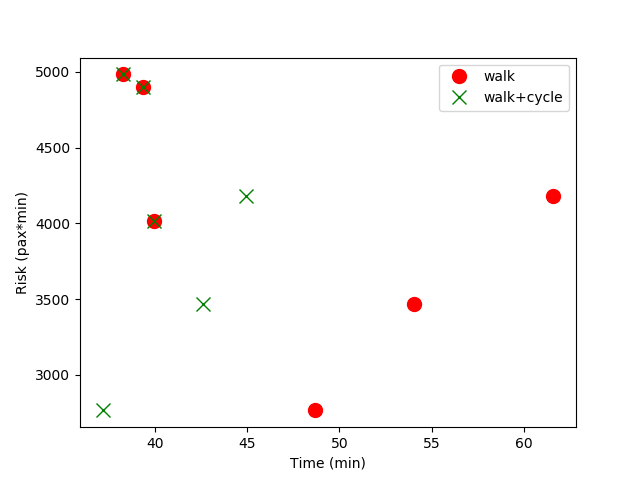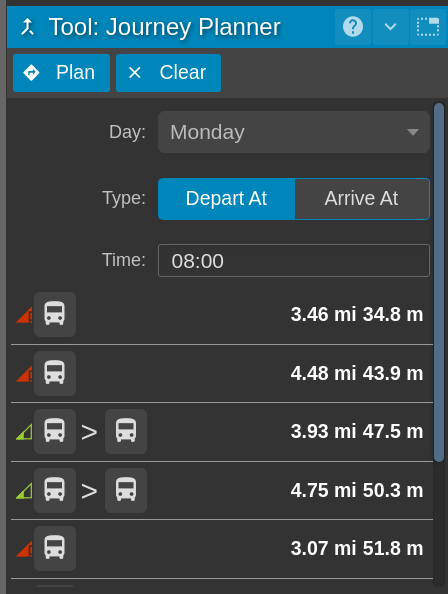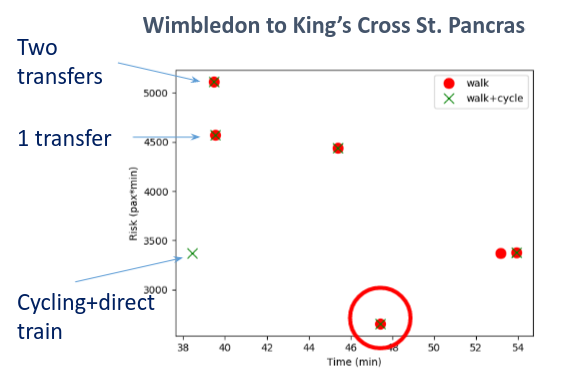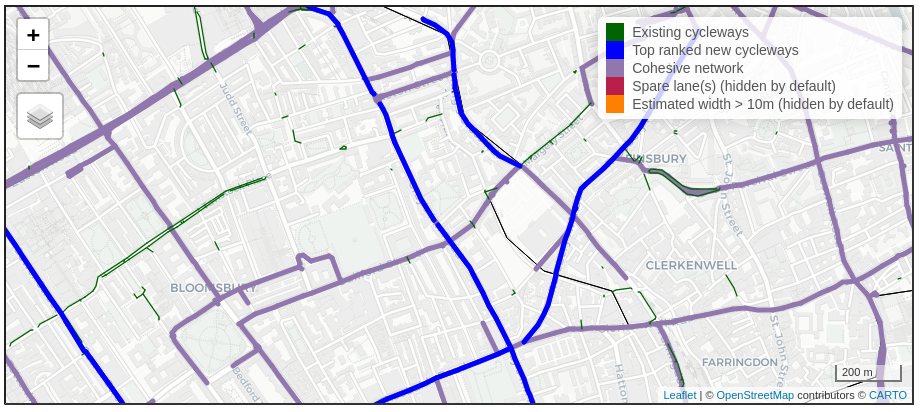As the UK's vaccine programme continues to make strides, with over 60% of adults now fully vaccinated, public transport operators are beginning to welcome cautious travellers back to bus and rail. However, there is still a cloud of fear preventing a return to public transport. Tube and buses are still operating at only half of the normal levels in London, contrasting with private vehicle usage, which returned to pre-pandemic peaks in late May 2021. Unless there is a significant change to this pattern, cities worldwide are doomed to experience substantial traffic congestion and increases in air pollution.
Earlier this year, with the support of EPSRC Impact Acceleration Accounts and in an effort to develop a system for the informed planning of socially distanced multi-modal journeys, Queen Mary University of London teamed up with Podaris to create TrustTransit - a method for planning multi-modal trips and assessing the risk of transport-related COVID-19 exposure across different transit networks.
Objectives
Despite the rapid and successful vaccination rollout, COVID is here for the long run. Recent research reveals that transfers at the busiest tube stations and longer commuting times using London underground correlate with the spread of airborne infections. So whether for this pandemic, or the next, helping passengers feel safer and more informed public transport users is paramount in preventing a shift to congestion-causing unsustainable modes.
Existing public trip planning tools often provide multiple journey options for commuters to get from A to B. In addition, some of the more advanced tools can suggest a myriad of multi-modal public-transport trip combinations (e.g. ride-hailing, micro-mobility, and car-sharing legs). However, only a few of them (e.g. Google Maps, CityMapper, and Transit) have started introducing new features to help travellers assess how their trips may be impacted by COVID-19 – including publishing crowding information.
This study demonstrated the feasibility of such an approach using the multi-modal routing function within the Podaris platform to provide different routing options for key journeys across London. Each option is then assessed for risk of transport-related COVID-19 exposure, planning alternative mobility options with the assessed risk, prioritising cycle infrastructure using crowding information and informing both travellers and service providers.
TrustTransit enables travellers to choose less crowded and lower risk trip options — or even postpone their trips until conditions improve. For employers, the tool can help them better understand the risks associated with their employee's commute and propose, for example, staggered working hours. And for planners, it empowers strategic decision making around factors such as service frequency, the locations of new cycleways/hire stations, and better crowd management.
Multi-Modal Trip Planning
Outcomes observed by the team make a compelling case for TrustTranist. For example, the research found that walking just one leg of a three-leg journey could reduce exposure by as much as 48%. Furthermore, and perhaps counterintuitively, specific options, while the shortest travel time, exposed passengers to greater risk. In another example, simply taking a direct train, instead of changing, reduced the exposure risk by 10%.
Calculating the risk of COVID transmission was approximated for each leg of a journey by estimating the number of people encountered, and the duration spent in contact. Outdoor walking and cycling legs were considered to have little to no risk, whereas Underground legs accounted for the risk of intra-station walking times, platform waiting times, and the duration within the train. Thus, for each trip, TrustTranist calculated an overall score of risk for the end-to-end journey.
In looking at a trip from Gants Hill to King’s Cross St. Pancras, taking a Central line train to Chancery Lane and walking, cycling, or even scooting the rest was not only faster but lowered the risk by 45%.

Public Transport Routing Engines
TrustTransit designed a framework centred around the public transport routing engine, which powers the Podaris platform. Public transport routing is a well-studied domain, with many high-quality algorithms and tools available. However, these tools are primarily designed for end-user passenger trip planning, where they curtail and restrict the journey options to a reasonable subset. The results usually optimise for one or two criteria – the shortest travel time, the lowest cost, the fewest transfers, and so on.
Unlike existing tools, the routing engine, which powers the journey planning, isochrones, and agent-based simulations in Podaris, was developed for transport practitioners. It allows planners and modellers to configure arbitrary costs and objectives to plan journeys on an easily modifiable transit network to see the impact on route choice and travel times. The routing engine calculates the door-to-door journeys, accounting for ingress/egress legs, wait times, and in-vehicle travel times.
In the case of TrustTransit, Podaris was able to help reduce the computational complexity of solving the multi-objective problem of calculating the risk of a journey but providing the inputs needed to turn it into a multi-step decision problem. Podaris’ routing engine can either return the best journey options for a single trip or an exhaustive list of all of the possible ways to get from an origin to a destination. In a network as complex as London, that can be 1000s of options.
After the TrustTransit model scores the potential risk of individual journey options, the best candidates can then be shortlisted and displayed in Podaris for passengers so that they can make an informed decision.

Incorporating Cycling for Potential Cycleway Identification
The pandemic rapidly changed people’s cycling habits, with over a billion spent on bike sales in the UK and billions more provided in funding for active travel infrastructure. Interventions like pop-up cycle lanes have been introduced in cities to make essential trips safe during the pandemic. But with traffic now returning and reopening restaurants competing for outdoor spaces, which of these temporary lanes will become a permanent fixture, and where else should be reallocated for cycling remains an open question.
While active travel offers a welcomed alternative to the otherwise inevitable mode-shift to private vehicle usage for trips of short to medium distances, public transport is irreplaceable for many commuting trips within London. However, with the rise of bike-share schemes, and from this month, the start of London’s electric scooter rental trial, well-integrated cycleways can provide convenient and journey possibilities that are lower-risk than public transport only journeys.
Results from the TrustTransit case study demonstrated the marked and sustainable decrease in transmission risk possible for many journeys by incorporating a cycling transfer leg rather than taking another bus or train.
Wimbledon to King’s Cross is an example of one of these journeys. The fastest journey would require two transfers, while a marginally longer journey with only one transfer has a 10% lower level of risk. However, TrustTranist shows that a cycling leg can be incorporated for the lowest risk instead of transferring to another train.

These journey suggestions are helpful not only for passengers but also for planners and policymakers. The routes found by TrustTransit can be used to highlight cycling potential for new cycleways and complement the Propensity to Cycle Tool (PCT), which identifies priority locations for new cycleways, ranking roads by their estimated ‘cycling potential’.

The above shows the area south of King’s Cross in PCT, where the cycling leg with the lowest risk would end. As seen in the image, the route from Chancery Lane to King’s Cross lies along the top-ranked cycleway. However, there is no top-ranked cycleway from Russell Square to King’s Cross. So instead, the route would need to use the cohesive network or suggests the need for a new cycleway not considered in PCT. Systematic sampling of sources and destinations for trips and the subsequent analysis of trade-off routes could help estimate the potential of cycleways if passengers switched to active travel as part of their journeys.
About the Team
The project team is looking forward to presenting additional findings from the TrustTransit case study at the 19th Annual Transport Practitioners’ Meeting on the 8th of July.
Dr. Michal Weiszer is a Research Assistant at School of Engineering and Materials Science, Queen Mary University of London. His research interests span computer science and operational research with systems engineering approach. He has applied simulation models of systems in diverse areas from supply chain, air traffic management and utility networks. In order to balance different objectives within a system, Dr Weiszer has used multi-objective optimisation techniques with application in transportation networks (freight and passenger). His research often relies on Data-Centric approach to successfully model systems. He has published more than 25 scientific papers and been involved in EPSRC and industry supported research grants.
Dr. Jun Chen, Queen Mary University of London – Dr. Jun Chen is a Senior Lecturer in Engineering Science at QMUL. He received his PhD degree from the University of Sheffield. He has published more than 60 scientific papers in areas of multi-objective optimisation, interpretable fuzzy systems, data-driven modelling, and intelligent transportation systems. Dr. Chen is leading an ongoing EPSRC funded project (in total in excess of £1M) with BAEs, AirFrance-KLM, Rolls Royce, Manchester and Zurich Airports, and Simio plc, and is the Training Director of EPSRC Doctoral Training Centre on Data-Centric Engineering (in total in excess of £1.6M). He has also been the PI on four industrial projects with Anglian Water, 3 EPSRC IAA projects and was the CoI on three Innovate UK projects (with IMS and Tesco plc, and Siemens). From 2020, he serves as a full member of the EPSRC Peer Review College. From 2018, he is awarded Turing Fellow by the national artificial intelligence research institute – the Alan Turing Institute.
The QMUL team is supported with the transport planning and software development expertise of the Podaris team, who are passionate about making cities more liveable places. The Podaris team support customers ranging from cities planning new mass transit infrastructure to global consultancies reimagining bus networks. To discuss collaboration opportunities or learn more, please reach out to info@podaris.com.